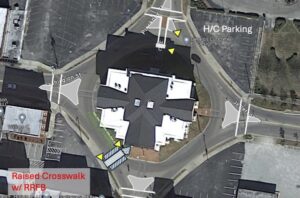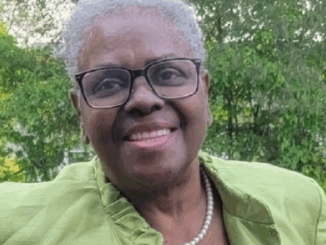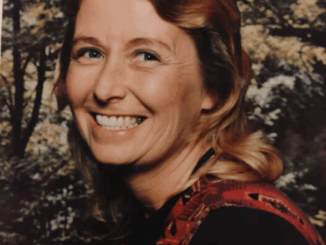
County leaders considered several alternatives to the plans for the original courthouse in Whiteville before settling on the one considered most consistent with a court order. One member of the board is still not satisfied with the board’s decision.
At the Jan. 17 commissioners meeting, County Commissioner Giles “Buddy” Byrd requested that County Manager Eddie Madden provide a detailed list of alternative proposals discussed in a meeting of the courthouse committee. Madden said that he had several pages of notes, but since the board had opted to follow the plan as laid out in the writ of mandamus, he had not compiled the notes into a single document.
Madden assembled a draft document containing brief descriptions of the alternatives as discussed. The memo can be seen here:
Courthouse options draft

Byrd has strenuously objected to the potential additional costs for providing security if the clerk’s office is placed in the old courthouse, among other issues. The commissioner said he felt the board members have a right to vote on the alternatives, and he wanted to be on the record voting against the current plan. Commission Chairman Ricky Bullard said that he had polled the board, and a majority of members were in favor of the plan approved by Sasser.
In 2020, county commissioners were instructed in a writ of mandamus to show how they planned to use the old courthouse. Then-Chief Resident Superior Court Judge Douglas Sasser lifted the writ in 2021 after the commissioners submitted the plan that is currently in place.
The 1918 courthouse has been closed since the annex was opened in 2017. Much of the $6 million renovation was paid for through state funding, with a $100,000 gift from local native Bill Valentine. The courthouse is currently set to include the clerk of court’s offices, Chief Resident Superior Court Judge Ashley Gore’s office, and the restored superior court room. Byrd and others suggested that the district court judges or public defender’s office be situated at the old courthouse.
The commissioners and county administration are responsible for assigning office locations for court staff.
Sheriff Bill Rogers initially requested an additional $600,000 for six deputies to provide security at the old courthouse. That cost has been dropped to around $120,000 each for two deputies.
Madden’s draft memo on alternative uses for the courthouse outlines the scenarios discussed by the board and committee.
The only options discussed for the second floor were the relocation of the Superior Court Judge’s office and a superior court room to the second floor, as planned in the original discussions about the courthouse restoration a decade ago.

For the first floor, Madden wrote that the commissioners could immediately allow the clerk’s offices to move into the restored offices; delay moving the clerk’s office until the new paperless court system comes online in 2025; leave the clerk’s office in the annex; or to divide the clerk’s office between the old courthouse and the annex.
The memo said that wills, estates, bookkeeping, and Hill’s personal office could be placed in the old courthouse, with the cashiers and criminal division remaining in the annex. That move would lessen foot traffic and free up office space for the district attorney, public defenders, and private attorneys to consult with clients.
Jacob Ward, a former assistant district attorney who is heading up the public defender’s office, said in an email to Madden and commissioners that he supports the original plan of moving then entire clerk’s operations to the old courthouse, and housing the PD’s office in the former clerk’s suite in the annex.
Ward said in an email to Madden that the PD’s office needs close proximity to the majority of courtrooms, as well as additional security.
“Having office space within the courthouse will permit more time spent in the courtroom and less time traveling to and from the courthouse,” Ward wrote. “It will also allow for a more efficient flow of clients from the courtrooms directly to the office. Meeting with clients and having adequate space to meet with multiple people at the same time is incredibly important. Having an office offsite will limit efficiency.”
Safety and security are also paramount, Ward said.
“By its very nature, Public Defender’s Offices meet daily with individuals in highly emotional states. Unfortunately, we see more and more violent encounters within our justice system. I do have a very serious concern for the safety of my staff.” He also noted that financially, placing the PD office in the current clerk’s suite would make sense, if Hill’s offices are moved to the old courthouse.
“I had the opportunity to walk through the space with Stuart Carroll …,” Ward wrote. “There are seven offices within clerk’s office, along with numerous cubicles. The layout of the office is ideal for my purposes. I plan on staffing a minimum of six full time attorneys in Columbus County, along with multiple support staff.”
Ward also noted that the furniture in the clerk’s office could serve his department, preventing the need to purchase more desks, chairs and other furnishings. The clerk’s office is already equipped with a “panic button” system to call deputies, who are stationed a few yards away.
Neither the Herring annex nor the former district attorney’s office would suffice without extensive renovations as well as additional dedicated security, Ward wrote.
Byrd and Chief Resident District Court Judge Scott Ussery have suggested that among their concerns are confusion about the location of the clerk’s office.
In December, Byrd said in an email to Madden that he was concerned over the request from Sheriff Bill Rogers to provide five additional bailiffs for the old courthouse, five days a week.
“We have known all along,” Byrd wrote, that we would have to increase the number of officers for the security of the old courthouse. I don’t know that there’s any pressing need that we would have to be in a hurry to do that.”
In an email response, Madden agreed, and said he felt the clerk’s office should remain in its current location.
“If the clerk remains in his current office location in the annex,” Madden wrote, “the sheriff can get by with one to two bailiffs (instead of five) on an as-needed basis when the superior court is in session. According to the sheriff, the clerk’s office would require five bailiffs, five days a week at the historic courthouse.
“From my vantage point, I do not see the need for the clerk of court to move to the historic courthouse. His current offices are larger and more convenient for the public. Furthermore, the sheriff doesn’t have the manpower to staff the historic courthouse with five bailiffs. He would likely have to pull his deputies off the road to provide the clerk with the number of bailiffs he would need.” Madden notes in the email that “the board will have to decide.”
“Totally agree,” Byrd replied. “Let the clerks office stay where it is. That was a main gripe of Jess (Hill) when trying to get a new courthouse built … he was afraid to carry court dockets across the street from the old courthouse to the annex building. We need to operate it as cheap as we can, so I agree let him stay where he’s at.”
Byrd and Ussery also said they had concerns about pedestrian safety.
Byrd said in the Jan. 17 meeting that Clerk of Superior Court Jess Hill had “come to us so many times about how dangerous it is to cross the street,” Byrd said. “…Now just before it’s done, we’re going to put the office there?”
Hill said he did not recall ever speaking to commissioners about traffic conditions around the courthouse. A check of commissioners meeting minutes as far back as 2011 does not make reference to Hill or his predecessor, Sheila Pridgen, discussing traffic with the board.
In a series of emails before and after the Jan. 12 committee meeting and the Jan. 17 board meeting, Madden asked Dept. of Transportation Division Engineer Ken Clark about ways to improve traffic flow and safety around the courthouse.

In an email to Stuart Carroll of the county facilities office, Clark said a sidewalk will need to be added to connect the raised pedestrian walkway between the annex and courthouse, along with a fence or hedges to prevent pedestrians from cutting across between the walkways. DOT funding might be available to modify the existing traffic islands and help with meeting Americans with Disabilities Act (ADA) wheelchair requirements.
The cost for the raised walkway and other improvements is expected to be around $200,000, with repaving raising the price to $335,000.

Madden instructed Carroll in a Jan. 25 email to ask Clark to “get us a contract so we can put it on the next agenda,” which would be next Monday’s meeting.
“With the courthouse set to reopen in June/July, it is imperative that the safety project move forward as quickly as possible,” Madden wrote.
Madden also discussed traffic issues with Whiteville City Manager Darren Currie, who forwarded Madden a list of “concerns” from Police Chief Douglas Ipock on Jan. 11.
Ipock suggested the clerk’s office remain in its current location in the annex, since “Getting into the current location for the clerk’s office is more convenient and doesn’t require people to cross a heavily traveled roadway.”
The chief noted that 10,000 vehicles per day travel the roundabout at the courthouse, and it has “Poorly marked pedestrian crosswalks” considering the anticipated increase in foot traffic. He suggested more signage warning of pedestrians will be needed, along with lighted signs on all four streets leading to the courthouse.
“If you are entering the roundabout, you can’t see if anyone is entering the crosswalk until you are rounding the corners,” Ipock wrote.
Currie noted that Emergency Management Director Hal Lowder “echoed some of the same comments.
“I would also say from a public service standpoint, it seems to me like it would be more confusing to the public about where they need to go for certain courts services,” Currie wrote.
Whether or not the contract would be on Monday’s agenda could not be determined at publication time. The commissioners agenda is usually available on the Friday before the regularly scheduled meeting.























